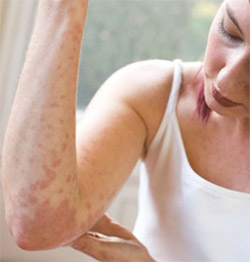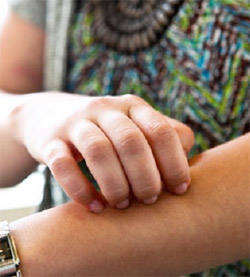|
|
Urticaria: A Distressing Disorder
 A rash sometimes triggered by an allergy, urticaria or Hives starts with
irregularly shaped, raised red weals that eventually become white or yellow with
a red rim. Depending on the trigger, the rash may string or itch. A rash sometimes triggered by an allergy, urticaria or Hives starts with
irregularly shaped, raised red weals that eventually become white or yellow with
a red rim. Depending on the trigger, the rash may string or itch.
Urticaria refers to a group of disorders in which wealing occurs in the skin.
The release of chemicals such as histamine causes small blood vessels to leak
and results in tissue swelling. The weals can be a few millimetres or several
centimetres in diameter, coloured white or red, often surrounded by a red flare,
and frequently itchy. Each weal may last a few minutes or several hours, and may
change shape. Weals may be round, or form rings, a map-like pattern, or giant
patches.
An allergy prompts the
immune system to make an antibody known as IgE, which releases the chemical histamine into the lower layers of the
skin. Histamine dilates the tiny blood capillaries of the skin, which leak
fluid into the surrounding tissue and cause it to swell into the rash.
Although urticaria can occur anywhere on the body, it
commonly shows up on the legs, arms and torso. The rash may come and go
over several hours, with some patches clearing and disappearing while new ones
arrive.
Types:
The surface weals may be accompanied by deeper swelling of eyelids, lips,
hands and elsewhere. The swelling is called angioedema. Angioedema may
occur with or without urticarial weals.
Urticaria (hives) is often classified according to how long it's been
present.
-
Acute urticaria is of recent onset (hours, days or a few weeks).
-
Chronic urticaria has been persistent for several months or years.
Urticaria may not be present all the time. Some find it more noticeable at
certain times of day, or when they are warm or emotionally upset.
Causes:
The cause of acute generalized urticaria often is undetermined (some
sources report that the cause is undetermined in more than 80% of cases), but it
may be related to the following:
-
 Infections (eg, pharyngitis, GI infections, genitourinary infections,
respiratory infections (asthma), fungal infections [eg, dermatophytosis],
malaria, amebiasis, hepatitis, mononucleosis, coxsackievirus, mycoplasmal
infections, infestations [eg, scabies], HIV, parasitic infections [eg,
ascariasis, strongyloidiasis, schistosomiasis, trichinosis]) Infections (eg, pharyngitis, GI infections, genitourinary infections,
respiratory infections (asthma), fungal infections [eg, dermatophytosis],
malaria, amebiasis, hepatitis, mononucleosis, coxsackievirus, mycoplasmal
infections, infestations [eg, scabies], HIV, parasitic infections [eg,
ascariasis, strongyloidiasis, schistosomiasis, trichinosis])
-
Food allergy (particularly shellfish, fish, eggs, cheese, chocolate, nuts,
berries, tomatoes). For some people, identifying what they are allergic to is
easy - they come out in red blotches if they eat a specific food such as
shellfish. Preventing an outbreak simply means avoiding the trigger.
-
Drugs (eg, penicillins, sulfonamides, salicylates, NSAIDS, codeine)
-
Environmental factors (eg, pollens, chemicals, plants, danders, dust, mold)
-
Exposure to latex
-
Exposure to cold or heat
-
-
Exercise
-
Pregnancy
(ie, pruritic urticarial papules and plaques of pregnancy [PUPPP])
Chronic Urticaria can be related to the following:
-
Cholinergic urticaria induced by emotional stress, heat, or exercise
(Examine for other signs of cholinergic stimulation including lacrimation,
salivation, and diarrhea.)
-
Chronic medical illness, such as hyperthyroidism, SLE, rheumatoid
arthritis, polymyositis, amyloidosis, polycythemia vera, carcinoma, and
lymphoma
Pregnancy
-
Cold urticaria, cryoglobulinemia, cryofibrinogenemia, syphilis, or
connective tissue disorder
Urticaria pigmentosa is a familial dermatologic disorder characterized by
hyperpigmented (yellow, tan, or brown) papules or plaques that may be associated
with lymphoproliferative disorders. These lesions are composed of mast cells.
When the skin overlying an individual lesion of urticaria pigmentosa is stoked,
a linear wheal is formed; this characteristic and diagnostic sign is known as
the Darier sign.
Recurrent
Urticaria can be related to the following:
Certain people can develop recurrent hives from sunlight, cold, pressure,
vibration or exercise. These are called the physical urticarias. If hives
develop from scratching or firmly rubbing the skin it is called dermatographism.
-
Sun exposure (solar urticaria, occur)
-
Exercise (cholinergic urticaria)
-
Emotional or physical stress
-
Water (aquagenic urticaria)
In susceptible persons, ingestion of certain foods or
medications before physical activity may be a predisposing factor for
exercise-induced urticaria
|
How are
Urticaria "triggers" identified?
As there are so many possible causes for urticaria, a determined detective work
on the part of the patient and physician. In some cases, the cause is never
identified.
 If allergy is suspected, keep a diary of foods eaten, any unusual exposures,
and when you have hives. Bring the diary with you to the allergist's office. To
unravel the urticaria puzzle, your allergist-immunologist will take a detailed
history, looking for clues in your lifestyle that will help pinpoint the cause
of your symptoms. You'll be asked about the frequency and severity of your
symptoms, your family's medical history, medications you're taking, your work
and home environment, and miscellaneous matters. The allergist will want to
review your diary
for further clues. If allergy is suspected, keep a diary of foods eaten, any unusual exposures,
and when you have hives. Bring the diary with you to the allergist's office. To
unravel the urticaria puzzle, your allergist-immunologist will take a detailed
history, looking for clues in your lifestyle that will help pinpoint the cause
of your symptoms. You'll be asked about the frequency and severity of your
symptoms, your family's medical history, medications you're taking, your work
and home environment, and miscellaneous matters. The allergist will want to
review your diary
for further clues.
In some cases you may require tests to analyze blood and urine, and other
procedures such as x-rays. If you are allergic to something more general, such
as a food preservative or additive, it can be much more
tricky to track down. Skin-patch tests-where a small ...
Treating Urticaria:
If you have urticaria, seek the advice of your doctor, who may refer
you to a dermatologist for advice. He or she will explain to you which type or
types of urticaria you have.
Oral antihistamines control wealing and itching for the majority of patients
with urticaria. They do not affect the underlying cause of the rash.
Antihistamines may need to be taken intermittently or continuously until the
underlying tendency to urticaria disappears.
Non-sedating antihistamines (loratidine, fexofenadine, terfenadine, cetirazine,
and astemizole) are less likely to cause drowsiness than the less expensive
conventional antihistamines. They may be unsuitable in pregnancy. Terfenadine
and astemizole may increase the risk of abnormal heart rhythms. They should be
avoided if you have
heart disease or you are also taking erythromycin, ketoconazole and some other medications. Fexofenadine, loratidine, desloratidine
and cetirazine are safe.
If the first antihistamine you try is not effective, consult your doctor. You
may need to increase the dose, or use a different drug. Sometimes a combination
of antihistamines works better than a single type alone. H2 blockers such as
cimetidine & ranitidine can also reduce urticaria but are more often prescribed
to reduce stomach acidity.
Urticaria that fails to clear with antihistamines may be helped by:
-
Oral steroids (prednisone) useful for severe acute urticaria but
unsuitable long term.
-
-
Trials of antibiotics and antifungal agents.
-
Immunosuppressive medications (cyclosporin, plasmapheresis).
-
Antifibrinolytic agents (tranexamic acid, androgenetic steroids such as
danazol)
If you have generalized urticaria, ask your doctor if a medicine could be the
cause.
Lifestyle Modifications:
-
Avoid aspirin and codeine; paracetamol and the newer Cox-II
inhibitor anti-inflammatories are usually tolerated.
-
Reduce your intake of acidic fruits. Don't consume food or confectionery
containing tartrazine (a yellow dye, numbered 102 in the list of ingredients
on the container), or meats preserved with benzoates (210-220)
-
Avoid alcohol.
-
Try not to overheat or to get uptight. Cool the affected area with a cold
flannel or ice pack.
-
Persons with solar urticaria should wear protective clothing and apply
sunscreen lotions when outdoors.
-
Avoid harsh soaps and frequent bathing to reduce the problem of dry skin,
which can cause itching and scratching that can aggravate urticaria. Vigorous
toweling after a bath may precipitate hives.
-
Modification of activities and behaviors is the mainstay of treatment in
patients with exercise-induced Urticaria. Patients should be educated to
(1) abstain from exercise four to six hours after eating; (2) avoid aspirin
and NSAIDs before exercising; (3) refrain from exercise around menses.
Whatever it is that controls a patients hives, should be the daily regimen,
taking the drugs every day, whether or not they have the hives on any given day.
The idea is that one is preventing the hives from breaking out. Remember to work
closely with the doctor to find a medication regimen that suppresses the hives
until they resolve on their own.
Related Links
|
|
|
|









